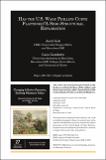Mostrar el registro sencillo del ítem
Has the U.S. wage phillips curve flattened? A semi-structural exploration
| dc.contributor.author | Galí, Jordi | |
| dc.contributor.author | Gambetti, Luca | |
| dc.date.accessioned | 2020-09-30T15:20:54Z | |
| dc.date.available | 2020-09-30T15:20:54Z | |
| dc.date.issued | 2020 | |
| dc.identifier.issn | 978-956-7421-67-1 | |
| dc.identifier.issn | 978-956-7421-68-8 (pdf) | |
| dc.identifier.uri | https://hdl.handle.net/20.500.12580/4882 | |
| dc.description | The deep and prolonged recession triggered by the global financial crisis of 2007–2009 led to a large increase in the unemployment rate in most advanced economies. Ten years later, at the time of writing this paper, the recession has long ended, and the subsequent recoveries have brought the unemployment rate to levels close to, and in some cases even below, those at the peak of the previous expansion. In the U.S., the unemployment rate increased from 4.4 percent in May 2007 to 10 percent in November 2009. Since that peak was attained, the unemployment rate has decreased, albeit at a slower pace than in earlier recoveries, down to its current level below 4 percent. Both movements represent, respectively, the largest increase and the largest decrease in the unemployment rate experienced by the U.S. economy during the postwar period. | es_ES |
| dc.description.abstract | The deep and prolonged recession triggered by the global financial crisis of 2007–2009 led to a large increase in the unemployment rate in most advanced economies. Ten years later, at the time of writing this paper, the recession has long ended, and the subsequent recoveries have brought the unemployment rate to levels close to, and in some cases even below, those at the peak of the previous expansion. In the U.S., the unemployment rate increased from 4.4 percent in May 2007 to 10 percent in November 2009. Since that peak was attained, the unemployment rate has decreased, albeit at a slower pace than in earlier recoveries, down to its current level below 4 percent. Both movements represent, respectively, the largest increase and the largest decrease in the unemployment rate experienced by the U.S. economy during the postwar period. | es_ES |
| dc.format | ||
| dc.format.extent | Sección o Parte de un Documento | |
| dc.format.medium | p. 149-172 | |
| dc.language.iso | en | es_ES |
| dc.publisher | Banco Central de Chile | es_ES |
| dc.relation.ispartof | Series on Central Banking Analysis and Economic Policies no. 27 | |
| dc.relation.ispartof | Serie Banca Central, análisis y políticas económicas, no. 27 | |
| dc.rights | Attribution-NonCommercial-NoDerivs 3.0 Chile | * |
| dc.rights.uri | http://creativecommons.org/licenses/by-nc-nd/3.0/cl/ | * |
| dc.subject | CRISIS FINANCIERA | es_ES |
| dc.subject | DESEMPLEO | es_ES |
| dc.title | Has the U.S. wage phillips curve flattened? A semi-structural exploration | es_ES |
| dc.type.doc | Artículo |


